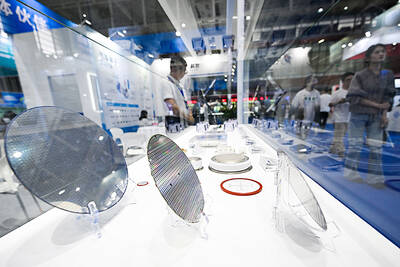Electronics parts maker Lite-On Technology Corp (光寶科技) expects revenue to grow by a single-digit percentage this year, attributed to rising demand for units used in cloud-computing servers, high-end camera modules and LED lighting, company executives said yesterday.
“These three products are likely to account for 30 percent of the company’s overall revenue this year, up from about 20 percent last year,” Lite-On said.
“Growth of the company’s bottom line is likely to outpace revenue growth this year, as Lite-On has been focusing on developing new and higher-margin products,” chief executive officer Warren Chen (陳廣中) told a media briefing yesterday.
“We recorded 6 percent annual growth in revenue last year, which is an uphill battle for same-scale companies like Lite-On to achieve,” Chen said. “We expect to see mild growth this year, too.”
New products including outdoor lighting, automotive headlights and rear lights, as well as components for industrial automation and medical devices will expand at the fastest pace; contributing about 20 percent of revenue, Chen said.
“We expect to see quite good growth for automotive electronics in 2017,” Chen said. “In addition to headlights and rear lights for cars, we are also supplying new cameras for autonomous cars for US and European automakers.”
Chen said the company is making progress toward its goal of doubling its share of the global car headlight market to 20 percent by 2019.
Lite-On, which commands 10 percent of the worldwide automotive headlight market, has landed orders from the world’s top five car light manufacturers to supply head lights and rear lights, Chen said.
Lite-On’s revenue rose to NT$229.54 billion (US$7.19 billion) last year, compared with NT$216.8 billion in 2015. In the first three quarters, net profit surged 45 percent year-on-year to NT$6.83 billion from NT$4.72 billion in the corresponding period in 2015.
Responding to questions about US president-elect Donald Trump’s call for companies to move manufacturing to the US, Chen said he “is conservative about this.”
To build a component manufacturing plant, companies need to consider whether they can reach an economic scale and the plant needs an ecosystem to support the production, Chen said.
“It will be more likely to assemble [car lights] in the US. It will be more difficult to produce components and modules,” Chen said.
Lite-On makes components for automotive lights in Mexico, he said.

Taiwan’s exports soared 56 percent year-on-year to an all-time high of US$64.05 billion last month, propelled by surging global demand for artificial intelligence (AI), high-performance computing and cloud service infrastructure, the Ministry of Finance said yesterday. Department of Statistics Director-General Beatrice Tsai (蔡美娜) called the figure an unexpected upside surprise, citing a wave of technology orders from overseas customers alongside the usual year-end shopping season for technology products. Growth is likely to remain strong this month, she said, projecting a 40 percent to 45 percent expansion on an annual basis. The outperformance could prompt the Directorate-General of Budget, Accounting and

The demise of the coal industry left the US’ Appalachian region in tatters, with lost jobs, spoiled water and countless kilometers of abandoned underground mines. Now entrepreneurs are eyeing the rural region with ambitious visions to rebuild its economy by converting old mines into solar power systems and data centers that could help fuel the increasing power demands of the artificial intelligence (AI) boom. One such project is underway by a non-profit team calling itself Energy DELTA (Discovery, Education, Learning and Technology Accelerator) Lab, which is looking to develop energy sources on about 26,305 hectares of old coal land in

Netflix on Friday faced fierce criticism over its blockbuster deal to acquire Warner Bros Discovery. The streaming giant is already viewed as a pariah in some Hollywood circles, largely due to its reluctance to release content in theaters and its disruption of traditional industry practices. As Netflix emerged as the likely winning bidder for Warner Bros — the studio behind Casablanca, the Harry Potter movies and Friends — Hollywood’s elite launched an aggressive campaign against the acquisition. Titanic director James Cameron called the buyout a “disaster,” while a group of prominent producers are lobbying US Congress to oppose the deal,

Two Chinese chipmakers are attracting strong retail investor demand, buoyed by industry peer Moore Threads Technology Co’s (摩爾線程) stellar debut. The retail portion of MetaX Integrated Circuits (Shanghai) Co’s (上海沐曦) upcoming initial public offering (IPO) was 2,986 times oversubscribed on Friday, according to a filing. Meanwhile, Beijing Onmicro Electronics Co (北京昂瑞微), which makes radio frequency chips, was 2,899 times oversubscribed on Friday, its filing showed. The bids coincided with Moore Threads’ trading debut, which surged 425 percent on Friday after raising 8 billion yuan (US$1.13 billion) on bets that the company could emerge as a viable local competitor to Nvidia